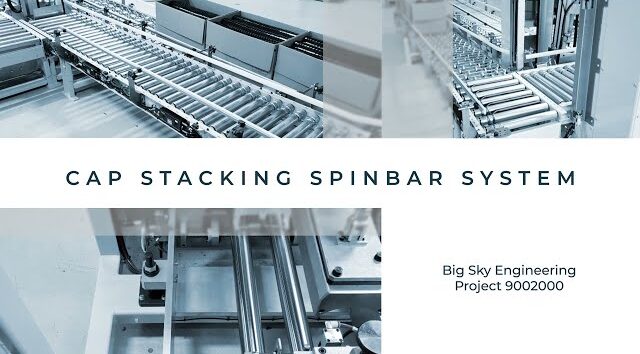SITUATION
The purchasing customer expressed the desire to expand its packaging operations for various closures. This presented an opportunity to create a faster automation line. The former antiquated process was slower using unpredictable equipment with slow output rates.
OPPORTUNITY & IMPLEMENTATION
The project requirements included the machine being completely autonomous aside from the operator placing liners into the box with the polybag cuffed around the box’s top flaps. At its core, the requirements a packaging rate of 65 closures per minute. The closures need to be packaged unmarked and in various rows. Initially, the machine was designed to package one size closure. The customer requested a modified design that would handle multiple closures ranging from 100mm to 120mm. The customer required the changeover procedure to be minimal and able to be performed in under 10 minutes. The finalized machine can package closures at a rate of 90 CPM, surpassing all customer expectations.
Final Station Summary:
Closure In-Feed- Driven conveyors supply the machine with closures. The closures navigate through a twist
track on the interior of the machine to the spin bar assembly.
Spinbar Assembly- The spinbars continually rotate, closure orientation remains the same. The closures travel to the base of the spin bar assembly. Laser sensors detect closure presence. When the laser sensor detects a complete row of closures, the cap stop is activated, preventing incoming closures from entering the spin bar assembly. The Gantry Pickhead is activated to pick the completed log from the spin bar assembly.
Pickhead- The pickhead picks the row of stacked closures utilizing its vacuum blower system. A vacuum pressure sensor on the pickhead tooling measures the vacuum level. The log is picked from the spinbar assembly and placed into the box in the loading position. The gantry returns to the home position and waits for the next stacked row of closures.
Case Handling- The original machine design would allow the operator to stage two empty cases on the in-feed conveyor section and allow two cases to accumulate. The final in-feed design features five in-feed positions before the box loading/transfer position. The driven rollers automatically position all of the boxes on the in-feed conveyor toward the loading position. Transfer conveyors activate to position the box on transitions on the in-feed and out-feed conveyors.
Case Locating- The case locating station uses clamps and locate tooling to position the box in place while forming the inserted polybag. The box loading/transfer conveyor features table tilt. The case will tilt in the loading position to keep the stacked logs in position.
Case Completion- Upon completion of the loading cycle, the box tilt will retract to a level position. Clamps and locates will return to the home position, and conveyors will activate, transferring the box to the machine’s exterior and onto the out-feed conveyor.
DESIGN FEATURES & SPECIFICATIONS
- Single Log High Flow Vacuum Pickhead
- Integrated guard enclosure with interlocked doors
- AB PLC Panelview Plus Display
- Class 3 guard enclosure.
- Output is 90+ CPM.
- Stack Light Indicators and audible alarms display the current machine state.
- Allen-Bradley 10” PanelView HMI
- The machine HMI uses customary pictures & buttons for control overrides. All machine sequences can be
operated in manual mode on the HMI. Current cycle rates and station information are displayed on the main
screen display.
Approximate Machine Dimensions: 187”L x 180”W x 145”H
Power Requirements: 480VAC, 3 Phase, 30A
Pneumatic Requirements: 80PSI-10 SCFM

